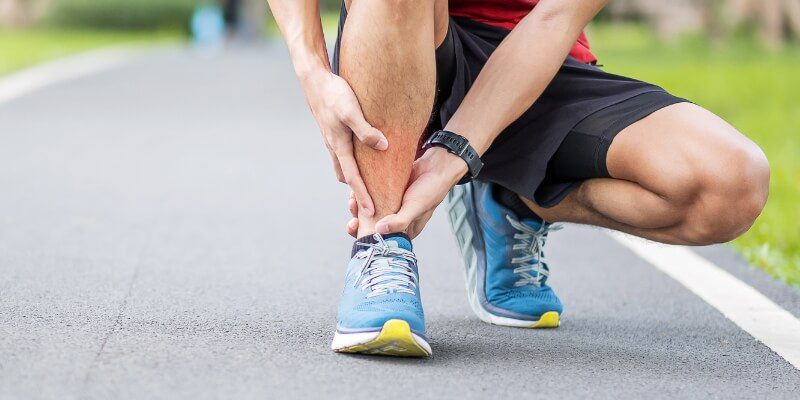
Understanding Shin Splints: Causes, Symptoms, and Effective Treatments
If you’ve ever had them, you’ll know that Shin Splints are a frustrating and painful condition. If you haven’t, you may be asking ‘What is a shin splint?’ Also known as Medial Tibial Stress Syndrome, shin splints can be extremely uncomfortable and disrupt training regimes.
People who take part in high-impact sports have the highest risk, but even walkers can develop shin splints, especially if they increase their speed or distance quickly. The good news is, that it’s not a serious condition and can be alleviated with some simple physiotherapy and at-home treatments.
Although shin splints are very common, the exact reason they occur is still unknown; however, many of the main risk factors are now well documented. In this article, we will look at the causes, diagnosis, and treatment of shin splints, as well as common shin splint symptoms.

What is a Shin Splint?
Shin splints, medically known as Medial Tibial Stress Syndrome, present as pain running along the shinbone, from the knee to the ankle. This condition can affect either side of the tibia and is often a result of damage and inflammation in the connective tissues surrounding the bone.
The pain is most prevalent during high-impact activities or extended periods of exercise but can also occur while at rest. Understanding what a shin splint is, forms the first step towards effective management and prevention.
Common Causes Leading to Shin Splints
Shin splints often stem from overworked muscles, tendons, and bone tissue. The most common causes include muscle tightness, biomechanical issues such as Pronation (flat feet) or Supination (high arches), and inadequate footwear or arch support. Common causes for Shin Splints are:
- Muscle tightness;
- Biomechanical abnormalities such as Pronation (flat feet) or Supination (high arch);
- Poor/inadequate footwear or arch support;
- Exercising without an appropriate warm-up/cool down;
- Weak ankles, hips, core muscles
Shin splints are usually caused by repeated or prolonged activity. This often occurs during excessive walking, running or jumping activities when insufficient training is involved; hence why they often occur in athletes who’ve recently intensified or changed their training routines.
Identifying Symptoms of Shin Splints
The hallmark symptom of shin splints is pain and tenderness along the inner side of the shin. This discomfort may initially manifest only during physical activity but can progress to a constant presence, even at rest, if left untreated. Muscle tightness often accompanies the pain and can worsen if the shin splints are not promptly addressed.
Shin splint symptoms can vary among individuals, but some of the most common symptoms include:
- Pain Along the Shinbone: This is the most characteristic symptom, where pain is felt along the inner side of the shinbone (tibia), typically extending from the knee to the ankle.
- Tenderness: The area around the shinbone may feel tender to the touch.
- Swelling: In some cases, the lower leg may become swollen.
- Muscle Pain: Pain might be felt in the muscles surrounding the shinbone.
- Numbness and Weakness: Some people may experience numbness or weakness in the feet due to the swelling affecting the nerves of the leg.
- Pain During Exercise: Pain often begins or worsens during exercise, particularly during running or other high-impact activities.
- Pain That Develops After Activity: Initially, shin splint pain might only be noticeable after finishing an exercise session.
- Pain That Worsens Over Time: If untreated, the pain can become more constant and severe, potentially even occurring during periods of rest.
- Increased Pain in the Morning: Some individuals with shin splints experience increased pain in the morning due to the tightening of the calf muscles overnight.
- Redness or Inflammation: The skin over the shinbone may appear red or inflamed.
It’s important to note that while these are common symptoms of shin splints, similar symptoms can also be indicative of other conditions, such as stress fractures or compartment syndrome. Therefore, a proper diagnosis from a healthcare professional is essential for appropriate treatment.

Effective Treatment Strategies for Shin Splints
Rest is the number one answer when it comes to effective shin splint treatment – this can take anywhere from 2-6 weeks depending on the severity of the injury. Gradual return to activity is recommended, only once the pain has subsided.
Ice should be applied to the area after activity if pain is present. Heat should be applied to the calf muscle to reduce muscle tightness, and can also be used as a shin splint treatment at any time, whether the pain is present or not. Anti-inflammatory painkillers such as Ibuprofen will help manage pain while recovering.
An exercise program targeted at correcting your biomechanics should also be used to treat shin splints once the pain has reduced. Starting this program too soon may lead to further injury and medical advice should be sought when starting an exercise recovery plan.
Advice on the correct footwear should be sought out to avoid injury when returning to normal activity levels. You may also find some stretches for shin splints very helpful in recovery.
Preventive Measures to Avoid Shin Splints
Prevention of shin splints involves addressing the root causes, thus minimising the need for shin splints treatment. Ensuring proper footwear, engaging in adequate warm-up and cool-down exercises, and strengthening the ankles, hips, and core muscles are crucial steps.
Gradually increasing the intensity and duration of training sessions can also help prevent the overworking of muscles, tendons, and bone tissues. Regular stretching, especially for athletes and those involved in high-impact sports, is essential in maintaining flexibility and reducing the risk of shin splints.
Prognosis
Shin splints may take a while to recover fully, but seeking advice from your physiotherapist and sticking to the recovery plan properly will prevent the injury from reoccurring in the future.
Think you might be suffering from Shin Splints? Book in now and talk to one of our Core Physiotherapists and get to the source of the issue, so you can get back to enjoying a pain-free life!
